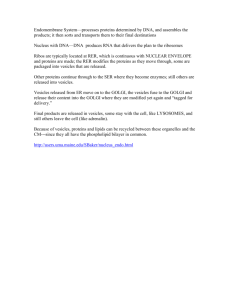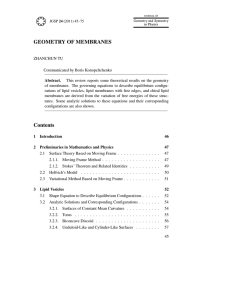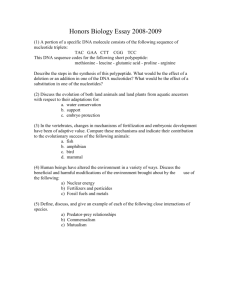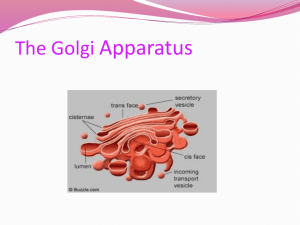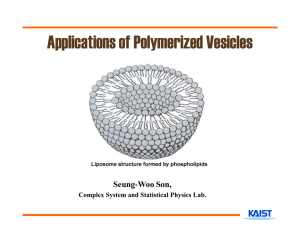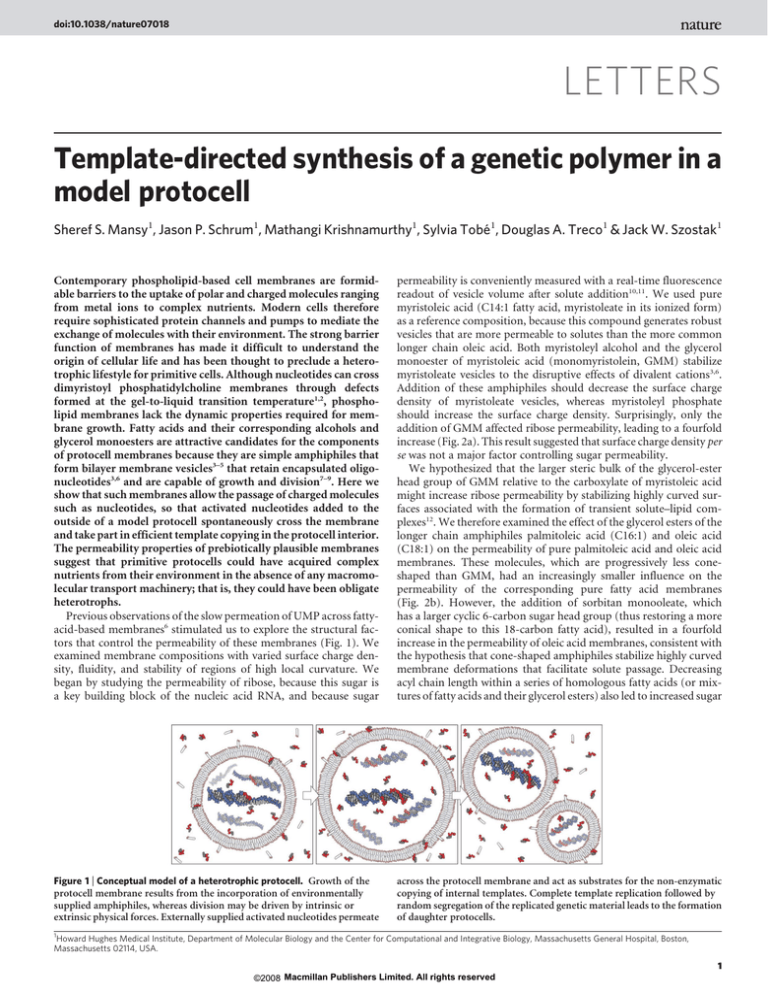
doi:10.1038/nature07018
LETTERS
Template-directed synthesis of a genetic polymer in a
model protocell
Sheref S. Mansy1, Jason P. Schrum1, Mathangi Krishnamurthy1, Sylvia Tobé1, Douglas A. Treco1 & Jack W. Szostak1
Contemporary phospholipid-based cell membranes are formidable barriers to the uptake of polar and charged molecules ranging
from metal ions to complex nutrients. Modern cells therefore
require sophisticated protein channels and pumps to mediate the
exchange of molecules with their environment. The strong barrier
function of membranes has made it difficult to understand the
origin of cellular life and has been thought to preclude a heterotrophic lifestyle for primitive cells. Although nucleotides can cross
dimyristoyl phosphatidylcholine membranes through defects
formed at the gel-to-liquid transition temperature1,2, phospholipid membranes lack the dynamic properties required for membrane growth. Fatty acids and their corresponding alcohols and
glycerol monoesters are attractive candidates for the components
of protocell membranes because they are simple amphiphiles that
form bilayer membrane vesicles3–5 that retain encapsulated oligonucleotides3,6 and are capable of growth and division7–9. Here we
show that such membranes allow the passage of charged molecules
such as nucleotides, so that activated nucleotides added to the
outside of a model protocell spontaneously cross the membrane
and take part in efficient template copying in the protocell interior.
The permeability properties of prebiotically plausible membranes
suggest that primitive protocells could have acquired complex
nutrients from their environment in the absence of any macromolecular transport machinery; that is, they could have been obligate
heterotrophs.
Previous observations of the slow permeation of UMP across fattyacid-based membranes6 stimulated us to explore the structural factors that control the permeability of these membranes (Fig. 1). We
examined membrane compositions with varied surface charge density, fluidity, and stability of regions of high local curvature. We
began by studying the permeability of ribose, because this sugar is
a key building block of the nucleic acid RNA, and because sugar
permeability is conveniently measured with a real-time fluorescence
readout of vesicle volume after solute addition10,11. We used pure
myristoleic acid (C14:1 fatty acid, myristoleate in its ionized form)
as a reference composition, because this compound generates robust
vesicles that are more permeable to solutes than the more common
longer chain oleic acid. Both myristoleyl alcohol and the glycerol
monoester of myristoleic acid (monomyristolein, GMM) stabilize
myristoleate vesicles to the disruptive effects of divalent cations3,6.
Addition of these amphiphiles should decrease the surface charge
density of myristoleate vesicles, whereas myristoleyl phosphate
should increase the surface charge density. Surprisingly, only the
addition of GMM affected ribose permeability, leading to a fourfold
increase (Fig. 2a). This result suggested that surface charge density per
se was not a major factor controlling sugar permeability.
We hypothesized that the larger steric bulk of the glycerol-ester
head group of GMM relative to the carboxylate of myristoleic acid
might increase ribose permeability by stabilizing highly curved surfaces associated with the formation of transient solute–lipid complexes12. We therefore examined the effect of the glycerol esters of the
longer chain amphiphiles palmitoleic acid (C16:1) and oleic acid
(C18:1) on the permeability of pure palmitoleic acid and oleic acid
membranes. These molecules, which are progressively less coneshaped than GMM, had an increasingly smaller influence on the
permeability of the corresponding pure fatty acid membranes
(Fig. 2b). However, the addition of sorbitan monooleate, which
has a larger cyclic 6-carbon sugar head group (thus restoring a more
conical shape to this 18-carbon fatty acid), resulted in a fourfold
increase in the permeability of oleic acid membranes, consistent with
the hypothesis that cone-shaped amphiphiles stabilize highly curved
membrane deformations that facilitate solute passage. Decreasing
acyl chain length within a series of homologous fatty acids (or mixtures of fatty acids and their glycerol esters) also led to increased sugar
Figure 1 | Conceptual model of a heterotrophic protocell. Growth of the
protocell membrane results from the incorporation of environmentally
supplied amphiphiles, whereas division may be driven by intrinsic or
extrinsic physical forces. Externally supplied activated nucleotides permeate
across the protocell membrane and act as substrates for the non-enzymatic
copying of internal templates. Complete template replication followed by
random segregation of the replicated genetic material leads to the formation
of daughter protocells.
1
Howard Hughes Medical Institute, Department of Molecular Biology and the Center for Computational and Integrative Biology, Massachusetts General Hospital, Boston,
Massachusetts 02114, USA.
1
©2008 Macmillan Publishers Limited. All rights reserved
LETTERS
NATURE
26
16
c
O
So
rb
.
A:
O
0
O
A
0
M
1
G
1
A:
2
O
2
PA PA
:G
M
PA
3
b
M MA
A:
G
M
M
3
M
A:
G
M
M
4
M
A:
M
P
4 a
M
A
M
A:
M
AO
H
Relative permeability
permeability (Fig. 2b and Supplementary Table 1), presumably
owing to the decreased stability of the ideal bilayer structure with
respect to the formation of transient solute–lipid complexes.
To investigate further the idea that local membrane deformations
are required for solute passage across the membrane, we asked
whether increased packing disorder within the lipid bilayer would
enhance permeability. Phospholipids with higher degrees of unsaturation yield more disordered, fluid membranes that are more permeable to water and small solutes13. We observed a fivefold increase
in ribose permeability for vesicles composed of linoleic acid (C18:2)
versus oleic acid (C18:1). Branched-chain amphiphiles such as the
isoprenoid farnesol also increase the fluidity of phospholipid membranes14. Vesicles made from a 2:1 molar mixture of myristoleic acid
and farnesol exhibited a ,17-fold increase in ribose permeability
relative to pure myristoleic acid vesicles. Conversely, the higher packing density of saturated amphiphiles13 should lead to increased membrane order and decreased solute permeability. As expected, the
addition of lauric acid (C12:0) to myristoleic acid vesicles (2:1 myristoleic acid:lauric acid) resulted in a twofold decrease in ribose permeability (Fig. 2c).
The above experiments show that solute permeability can be
increased by decreasing acyl chain length, by increasing acyl chain
unsaturation or branching, and by adding amphiphiles with larger
head groups. The most prebiotically plausible amphiphiles are the
short chain saturated fatty acids and their corresponding alcohols
and glycerol esters15–17. To see whether shorter chain length could
compensate for the loss of unsaturation, we tested membrane compositions based on the C10 amphiphiles decanoic acid and decanol
(DOH) as well as the glycerol monoester of decanoate (GMD). Pure
decanoic acid only forms stable vesicles at very high amphiphile
concentrations ($100 mM), but the addition of decanol decreases
the critical aggregate concentration to ,20 mM and increases the pH
range over which vesicles are stable3. We found that the ribose permeability of 2:1 decanoate:decanol vesicles is very similar to that of
myristoleic acid vesicles but is significantly less than that of myristoleic acid:GMM vesicles (Fig. 2d). Based on the observations that
d
12
23
8
20
4
M
A:
G
M
M
e
A
at
le
O
no
Li
ol
es
rn
fa
DA
:D
O
DA
H
:D
O
H
:G
M
D
M
A:
M
A
M
A:
LA
M
A
0
2–3
Figure 2 | Ribose permeability of fatty acid based membranes.
a–c, Influence of head group charge (a), head group size (b) and membrane
fluidity (c). d, Comparison of decanoic-acid-based membranes with
myristoleic acid based membranes. All binary lipid mixtures were 2:1 molar
ratios of fatty acid:additive; a 4:1:1 ratio of decanoic acid:DOH:GMD was
used. Ribose permeabilities are relative to that of myristoleic acid
membranes. DA, decanoic acid; DOH, decanol; GMD, glycerol monoester of
decanoic acid; GMM, glycerol monoester of myristoleate; GMO, glycerol
monoester of oleate; GMPA, glycerol monoester of palmitoleate; LA, lauric
acid; MA, myristoleic acid; MA-OH, myristoleoyl alcohol; MP, myristoleoyl
phosphate; OA, oleate; PA, palmitoleic acid; Sorb., sorbitan monooleate.
amphiphiles with larger head groups lead to increased permeability,
we replaced half of the decanol with glycerol mono-decanoate. The
resulting vesicles exhibited a tenfold increase in ribose permeability
(Fig. 2d). It is particularly notable that improved permeability and
stability are obtained with mixtures of amphiphiles, such as might be
expected to be present in a chemically rich prebiotic environment.
This is in marked contrast to the situation with nucleic acids, where
homogeneous nucleotides are thought to be required for replication.
Vesicles with all of the above membrane compositions retained
100% of an encapsulated fluorescein-labelled dA10 oligonucleotide
indefinitely (Supplementary Fig. 6). In addition, all membrane compositions retained the previously observed 3–10-fold faster permeation of ribose compared to its diastereomers arabinose, lyxose and
xylose (Supplementary Table 1). These observations show that our
permeability measurements do not reflect leakage of encapsulated
materials caused by vesicle rupture or the formation of large nonselective pores.
Having established that membranes composed of prebiotically
plausible amphiphilic molecules have high permeabilities to simple
sugars, we asked whether such membranes would allow the uptake of
nucleotide nutrients by a simple model protocell. We measured nucleotide permeation by encapsulating nucleotides within vesicles and
then determining the fraction of the encapsulated nucleotide that had
leaked out of the vesicles at various times. Because charge has such a
dominant effect in restricting solute permeation through membranes, we first examined the effect of nucleotide charge on permeation through myristoleic acid:GMM (2:1) membranes. We observed
negligible leakage of AMP, ADP or ATP (with 2, 3 and 4 negative
charges at pH 8.5, respectively) over 24 h in the absence of Mg21,
suggesting that these molecules were either too large or too highly
charged to cross the membrane. We did observe slow permeation of
AMP and ADP in the presence of 3 mM Mg21 (Fig. 3a), as expected
from the formation of complexes of reduced net charge18. The impermeability of ATP argues against a role for NTPs in very early forms of
cellular life dependent on externally synthesized activated nucleotides; instead, NTPs may be a later evolutionary adaptation that
prevents the leakage of internally synthesized activated nucleotides19.
The above results highlight the importance of reducing the net
charge of nucleotides to enhance membrane permeability.
Imidazole-activated nucleotides have been used as convenient models of prebiotic activated nucleotides in studies of both spontaneous
and templated polymerization reactions20–23. In addition to their
higher intrinsic chemical reactivity compared to NTPs, these activated nucleotides are less polar and bear only a single negative charge
at a neutral to moderately alkaline pH. We therefore measured the
permeabilities of a series of adenosine nucleotides and their corresponding phosphorimidazolides, using both myristoleic acid:GMM
(2:1) and C10 membranes (4:1:1 decanoic acid:DOH:GMD;
Fig. 3b–d). The half-time for equilibration of nucleoside phosphorimidazolides using 100-nm vesicles was approximately 12 h. The
effects of membrane composition on the permeability of nucleoside
phosphorimidazolides were essentially parallel to our results for
sugar permeability—pure myristoleic acid vesicles were less permeable to nucleotides than myristoleic acid:GMM (2:1) vesicles,
whereas farnesol led to an even greater enhancement of permeability
(Supplementary Fig. 4). Similarly, the permeability of decanoic
acid:DOH membranes was enhanced by the addition of GMD
(Fig. 3d).
Our permeability data are consistent with a transport model in
which polar functional groups of solute molecules initially interact
with one or more amphiphile head groups with displacement of
bound water molecules (Supplementary Fig. 5), whereas non-polar
regions of the solute may interact with the hydrophobic acyl chains of
the amphiphiles24. Formation of this relatively non-specific amphiphile–solute complex is followed by a concerted inversion of the
complex across the membrane. Lipids with large head groups could
increase solute permeation by providing more opportunity for solute
2
©2008 Macmillan Publishers Limited. All rights reserved
LETTERS
In (percentage encapsulated)
NATURE
a
b
4.7
4.7
4.3
4.3
3.9
3.9
3.5
3.5
0
5
10
15
20
25
0
5
10
15
20
25
0
5
10
15
20
25
c
d
4.7
4.7
4.3
4.3
3.9
3.9
3.5
3.1
3.5
2.7
0
5
10
15
20
25
Time (h)
Figure 3 | Time courses of nucleotide permeation through fatty acid based
membranes. a, Nucleotide permeation across MA:GMM membranes. Filled
square, AMP; open square, AMP 1 3 mM MgCl2; filled circle, ADP; open
circle, ADP 1 3 mM MgCl2, filled triangle, ATP; open triangle, ATP 1 3 mM
MgCl2. b, Permeation of AMP derivatives across MA:GMM membranes.
Filled circle, adenosine-59-monophosphate; open circle, 29-deoxyadenosine59-monophosphate; open square, 29-amino-29,39-dideoxyadenosine-59monophosphate; filled diamond, 29-deoxyadenosine-59phosphorimidazolide. c, Permeability of activated nucleotides across
MA:GMM membranes. Filled square, adenosine-59-phosphorimidazolide;
filled circle, 29-amino-29,39-dideoxyadenosine-59-phosphorimidazolide;
open circle, 39-amino-39-deoxyadenosine-59-phosphorimidazolide.
d, Nucleotide permeation across DA:DOH:GMD and DA:DOH membranes.
Filled square, AMP; open square, dAMP; X, 29-amino-29,39dideoxyadenosine-59-monophosphate; filled diamond and asterisk,
adenosine-59-phosphorimidazolide; filled circle, 2’-deoxyadenosine-59phosphorimidazolide; open circle, 29-amino-29,39-dideoxyadenosine-59phosphorimidazolide. All are for 4:1:1 DA:DOH:GMD membranes except
for the asterisk, which is 2:1 DA:DOH.
interaction, by favouring high local curvature and by decreasing the
cohesive interactions between adjacent acyl chains and thereby facilitating amphiphile flip-flop. This model is similar to the previously
proposed carrier model for the spontaneous transport of monovalent
ions across fatty acid25 and phospholipid membranes26.
Encouraged by the observed permeability of activated nucleotides,
we asked whether such nucleotides added to the outside of a model
protocell could diffuse to the inside and engage in template-copying
a
reactions in the vesicle interior. Although no sequence-general means
for the non-enzymatic replication of a genetic polymer has yet been
found, we have identified a system that exhibits remarkably rapid and
efficient non-enzymatic copying of an oligo-dC DNA template
(Supplementary Fig. 7). We used this system to model the spontaneous chemical replication of genetic material within a protocell. In
brief, a DNA primer bearing a single 39-amino-nucleotide at its
39 terminus27 was annealed to a DNA oligonucleotide consisting of
a primer-binding region and a (dC)15 template region. After the
addition of 29-amino, 29-39-dideoxyguanosine 59-phosphorimidazolide, the primer was extended by the template-directed synthesis of
29-phosphoramidate-linked DNA. Both 39- and 29-amino nucleotides polymerized much more rapidly than similarly activated riboor deoxyribo-nucleotides owing to the presence of the more nucleophilic amino group23. In solution, primer-extension across a (dC)15
template in the presence of 5 mM activated 29-amino-guanosine is
essentially complete within 6 h (Fig. 4a). The principal product is
full-length extended primer.
We used the reaction described previously to test the chemical and
physical compatibility of template-directed copying with the integrity of fatty-acid-based vesicles. We examined the same templatecopying reaction inside two sets of vesicles: the robust laboratory
model system consisting of myristoleic acid:GMM (2:1) vesicles,
and the more prebiotically plausible decanoic acid:DOH:GMD
(4:1:1) vesicles. Vesicles containing encapsulated primer-template
were purified to remove unencapsulated primer-template. We added
5 mM activated 29-amino-guanosine to initiate template copying,
removed aliquots at intervals, and again purified the vesicles to
remove traces of primer-template that might have leaked out of the
vesicles. The absence of measurable leakage of oligonucleotides from
the vesicles shows that the activated nucleotides do not disrupt vesicle
structure. Analysis of the reaction products showed significant primer-extension by 3 h, with full-length product continuing to accumulate until 24 h, at which point the vesicle reactions had reached a
level of full-length product comparable to that seen in the solution
reactions (Fig. 4). Thus, myristoleic acid:GMM or decanoic
acid:DOH:GMD membranes slow the interaction between the primer-template and activated nucleotides, but are nevertheless compatible with template-copying chemistry in the vesicle interior. As
expected, a similar experiment using myristoleic acid:farnesol (2:1)
vesicles also showed efficient copying of encapsulated template
(Fig. 4c). In contrast, phospholipid vesicles showed no detectable
primer extension after the addition of activated nucleotide to the
vesicle exterior (Fig. 4d).
The results described above bear directly on the two current contrasting views of the nature of protocells: the autotrophic and hetb
Time (h) 0 1 3 6 12 24 / 0 1 3 6 1224
c
0 3 6 1224
0 3 24
d
0 24
Primer (15 nts)
Figure 4 | Template-copying chemistry inside vesicles. Vesicles contained
encapsulated primer-template complexes, and template-copying was
initiated by the addition of activated monomer to the external solution. nts,
nucleotides. a, Non-enzymatic dC15-template copying in solution (lanes
1–6) and inside 2:1 MA:GMM vesicles (lanes 8–13) at 4 uC. b, Template-
copying reaction in 4:1:1 DA:DOH:GMD vesicles at 25 uC. c, Templatecopying reaction in 2:1 MA:farnesol vesicles at 4 uC. d, Template-copying
reaction in POPC vesicles at 4 uC. For a–c, the arrow denotes full-length
product. See Methods for reaction conditions.
3
©2008 Macmillan Publishers Limited. All rights reserved
LETTERS
NATURE
erotrophic models28–30. The autotrophic or ‘metabolism first’ model
is based on the idea that autocatalytic reaction networks evolved in a
spatially localized manner to generate in situ the building blocks
required for cellular replication. Our results argue that early protocells with fatty-acid-based membranes could not have been autotrophs, because internally generated metabolites would leak out. In
contrast, the heterotrophic model posits the emergence of very simple cellular structures within a complex environment that provides
external sources of nutrients and energy. Although both models must
overcome numerous conceptual difficulties related to the origin of
complex molecular building blocks, the heterotrophic model was
thought to face the additional difficulty of importing polar and even
charged molecules across a bilayer lipid membrane. We have shown
that fatty-acid-based membranes allow a simple protocell to acquire
critical nutrients, while retaining polymerized nucleic acids indefinitely. Our results therefore support the idea that extremely simple
heterotrophic protocells could have emerged within a prebiotic
environment rich in complex nutrients.
METHODS SUMMARY
Sugar permeability. Vesicles were prepared with 10 mM encapsulated calcein in
either 0.1 M POPSO (piperazine-1,4-bis(2-hydroxypropanesulfonic acid) dihydrate) and 3 mM EDTA (pH 8.2) or 0.1 M POPSO and 3 mM MgCl2 (pH 8.2).
Final sugar concentrations were either 0.5 M or 0.1 M. Permeability was measured by the shrink–swell assay11 on an Applied Photophysics SX.18MV-R
stopped-flow spectrometer at 23 uC.
Nucleotide permeability. Nucleotide permeability measurements were in 0.2 M
sodium bicine (pH 8.5) at 23 uC and measured either by monitoring the leakage
of entrapped nucleotide by radioactivity or by ultraviolet absorption. Separation
of vesicle-entrapped and -released nucleotide was by gel filtration.
Primer extension reactions. Reactions contained 0.1 mM 32P-labelled 39-aminoterminated primer, 0.5 mM template DNA, 100 mM 1-(2-hydroxyethyl)-imidazole and 200 mM sodium bicine (pH 8.5). Reactions were initiated by the addition of 5 mM 29-amino-29,39-dideoxyguanosine-59-phosphorimidazolide and
incubated at 4 uC. Samples were analysed by electrophoresis on a denaturing
17% polyacrylamide gel. Reaction products were visualized using a Typhoon
9410 PhosphorImager.
Full Methods and any associated references are available in the online version of
the paper at www.nature.com/nature.
Received 29 October 2007; accepted 22 April 2008.
Published online 4 Jun 2008.
1.
2.
3.
4.
5.
6.
7.
8.
9.
Chakrabarti, A. C., Breaker, R. R., Joyce, G. F. & Deamer, D. W. Production of RNA
by a polymerase protein encapsulated within phospholipid vesicles. J. Mol. Evol.
39, 555–559 (1994).
Monnard, P. A., Luptak, A. & Deamer, D. W. Models of primitive cellular life:
polymerases and templates in liposomes. Phil. Trans. R. Soc. Lond. B 362,
1741–1750 (2007).
Apel, C. L., Deamer, D. W. & Mautner, M. N. Self-assembled vesicles of
monocarboxylic acids and alcohols: conditions for stability and for the
encapsulation of biopolymers. Biochim. Biophys. Acta 1559, 1–9 (2002).
Blochliger, E., Blocher, M., Walde, P. & Luisi, P. L. Matrix effect in the size
distribution of fatty acid vesicles. J. Phys. Chem. B 102, 10383–10390 (1998).
Hargreaves, W. R. & Deamer, D. W. Liposomes from ionic, single-chain
amphiphiles. Biochemistry 17, 3759–3768 (1978).
Chen, I. A., Salehi-Ashtiani, K. & Szostak, J. W. RNA catalysis in model protocell
vesicles. J. Am. Chem. Soc. 127, 13213–13219 (2005).
Chen, I. A., Roberts, R. W. & Szostak, J. W. The emergence of competition
between model protocells. Science 305, 1474–1476 (2004).
Chen, I. A. & Szostak, J. W. A kinetic study of the growth of fatty acid vesicles.
Biophys. J. 87, 988–998 (2004).
Hanczyc, M. M., Fujikawa, S. M. & Szostak, J. W. Experimental models of primitive
cellular compartments: encapsulation, growth, and division. Science 302,
618–622 (2003).
10. Chen, P. Y., Pearce, D. & Verkman, A. S. Membrane water and solute permeability
determined quantitatively by self-quenching of an entrapped fluorophore.
Biochemistry 27, 5713–5718 (1988).
11. Sacerdote, M. G. & Szostak, J. W. Semipermeable lipid bilayers exhibit
diastereoselectivity favoring ribose. Proc. Natl Acad. Sci. USA 102, 6004–6008
(2005).
12. Israelachvili, J. N. Intermolecular and Surface Forces (Academic, London, 1992).
13. Lande, M. B., Donovan, J. M. & Zeidel, M. L. The relationship between membrane
fluidity and permeabilities to water, solutes, ammonia, and protons. J. Gen. Physiol.
106, 67–84 (1995).
14. Rowat, A. C., Keller, D. & Ipsen, J. H. Effects of farnesol on the physical properties
of DMPC membranes. Biochim. Biophys. Acta 1713, 29–39 (2005).
15. Deamer, D. W. Boundary structures are formed by organic components of the
Murchison carbonaceous chondrite. Nature 317, 792–794 (1985).
16. Huang, Y. et al. Molecular and compound-specific isotopic characterization of
monocarboxylic acids in carbonaceous meteorites. Geochim. Cosmochim. Acta 69,
1073–1084 (2005).
17. McCollom, T. M., Ritter, G. & Simoneit, B. R. Lipid synthesis under hydrothermal
conditions by Fischer–Tropsch-type reactions. Orig. Life Evol. Biosph. 29, 153–156
(1999).
18. Khalil, M. M. Complexation equilibria and determination of stability constants of
binary and ternary complexes with ribonucleotides (AMP, ADP, and ATP) and
salicylhydroxamic acid as ligands. J. Chem. Eng. Data 45, 70–74 (2000).
19. Westheimer, F. H. Why nature chose phosphates. Science 235, 1173–1178 (1987).
20. Eschenmoser, A. The search for the chemistry of life’s orgin. Tetrahedron 63,
12821–12844 (2007).
21. Ferris, J. P., Hill, A. R., Liu, R. & Orgel, L. E. Synthesis of long prebiotic oligomers on
mineral surfaces. Nature 381, 59–61 (1996).
22. Kozlov, I. A., Pitsch, S. & Orgel, L. E. Oligomerization of activated D- and
L-guanosine mononucleotides on templates containing D- and L-deoxycytidylate
residues. Proc. Natl Acad. Sci. USA 95, 13448–13452 (1998).
23. Tohidi, M., Zielinski, W. S., Chen, C. H. & Orgel, L. E. Oligomerization of the 39amino-39deoxyguanosine-59phosphorimidazolidate on a d(CpCpCpCpC)
template. J. Mol. Evol. 25, 97–99 (1987).
24. Wilson, M. A. & Pohorille, A. Mechanism of unassisted ion transport across
membrane bilayers. J. Am. Chem. Soc. 118, 6580–6587 (1996).
25. Chen, I. A. & Szostak, J. W. Membrane growth can generate a transmembrane pH
gradient in fatty acid vesicles. Proc. Natl Acad. Sci. USA 101, 7965–7970 (2004).
26. Paula, S. G., Volkov, A. G., Van Hoek, A. N., Haines, T. H. & Deamer, D. W.
Permeation of protons, potassium ions, and small polar molecules through
phospholipid bilayers as a function of membrane thickness. Biophys. J. 70,
339–348 (1996).
27. Hagenbuch, P., Kervio, E., Hochgesand, A., Plutowski, U. & Clemens, R. Chemical
primer extension: efficiently determining single nucleotides in DNA. Angew.
Chem. Int. Edn Engl. 44, 6588–6592 (2005).
28. Chen, I. A., Hanczyc, M. M., Sazani, P. L. & Szostak, J. W. in The RNA World (eds
Gesteland, R. F., Cech, T. R. & Atkins, J. F.) 57–88 (Cold Spring Harbor Laboratory
Press, Cold Spring Harbor, 2006).
29. Morowitz, H. J. Beginnings of Cellular Life: Metabolism Recapitulates Biogenesis
(Yale Univ. Press, New Haven, 2004).
30. Wachtershauser, G. Evolution of the first metabolic cycles. Proc. Natl Acad. Sci.
USA 87, 200–204 (1990).
Supplementary Information is linked to the online version of the paper at
www.nature.com/nature.
Acknowledgements This work was supported by grants from the NASA
Exobiology Program (EXB02-0031-0018) and the NSF (CHE-0434507) to J.W.S.
J.W.S. is an Investigator of the Howard Hughes Medical Institute. S.S.M. was
supported by the NIH (F32 GM07450601). We thank I. Chen, M. Hanczyc,
R. Bruckner, T. Zhu and Q. Dufton for discussions, and J. Iwasa for Fig. 1 and
Supplementary Fig. 5.
Author Contributions Permeability experiments were performed by S.S.M. J.P.S.
performed primer-extension experiments. M.K. synthesized 29-aminoguanosine.
S.T. and D.A.T. contributed to the development of the encapsulated
primer-extension system. All authors helped to design the experiments and
discussed the results. S.S.M., J.P.S. and J.W.S. wrote the paper.
Author Information Reprints and permissions information is available at
www.nature.com/reprints. Correspondence and requests for materials should be
addressed to J.W.S. (szostak@molbio.mgh.harvard.edu).
4
©2008 Macmillan Publishers Limited. All rights reserved
doi:10.1038/nature07018
METHODS
Materials. Fatty acids, fatty alcohols and the glycerol monoesters of fatty acids
were obtained from Nu-chek Prep, Inc. POPC (1-palmitoyl-2-oleoyl-sn-glycero3-phosphocholine) was from Avanti Polar Lipids, Inc. Myristoleoyl phosphate31–33 was synthesized as described previously. 29-amino-29,39-dideoxyguanosine-59-phosphorimidazolide was synthesized by first generating 29-azido29,39-dideoxyguanosine, as described previously 34, followed by phosphorylation
of the 29-azido-29,39-dideoxy nucleoside with POCl3 in triethyl phosphate,
activation with 1,19-carbonyl-diimidazole (CDI) to yield the 59-phosphorimidazolide, and reduction of the 29-azido group to the 29-amine by catalytic
hydrogenation. Nucleotide phosphorimidazolides were then purified by
reverse-phase HPLC on an Alltima C18 column (Alltech) equilibrated with
0.1 M triethylammonium bicarbonate/2% acetonitrile, pH 8.0, and eluted with
an acetonitrile gradient. Oligonucleotides were synthesized on an Expedite 8909
DNA synthesizer (Applied Biosystems). Template DNA (59-AACCCCCCC
CCCCCCCCCCAGTCAGTCTACGC-39) for primer extension reactions was
synthesized using standard phosphoramidite chemistry. 39-amino-terminated
DNA primer (59-GCGTAGACTGACTGG-NH2-39) was synthesized using
reverse phosphoramidites (Glen Research), with the final addition using a 39amino phosphoramidite (Transgenomic). Oligonucleotides were purified by
anion exchange HPLC on a DNAPac PA-100 column (Dionex) in 0.01 M
NaOH/0.01 M NaCl, pH 12.0, in a gradient up to 1.5 M NaCl.
Vesicle preparation. Fatty acid vesicles were prepared by oil dispersion in buffered solutions as described previously1,3. For vesicles composed of mixtures of
unsaturated amphiphiles, the oils were mixed before dispersion in aqueous
solution. Vesicles of mixed saturated and unsaturated composition were made
by first generating vesicles composed of the unsaturated amphiphile, extrusion
through 100 nm pore-size polycarbonate filters, followed by the addition of
micelles composed of the saturated fatty acid. All vesicle preparations were
extruded 11 times with an Avanti mini-extruder. For the encapsulation of molecules, amphiphiles were resuspended in the presence of the encapsulant followed
by freeze-thaw cycling to equilibrate internal and external solutes. Separation of
entrapped and unencapsulated material was by gel filtration with Sepharose-4B
resin (Sigma-Aldrich) in which the running buffer contained the same amphiphile composition as the vesicles at a concentration above their critical aggregate
concentration. Vesicle size was measured by dynamic light scattering with a
PDDLS/CoolBatch 90T from Precision Detectors.
Sugar permeability. Vesicles were prepared with 10 mM encapsulated calcein in
either 0.1 M POPSO and 3 mM EDTA, pH 8.2, or 0.1 M POPSO and 3 mM
MgCl2, pH 8.2. Final sugar concentrations were either 0.5 M or 0.1 M. Before
measurement, vesicle samples were diluted to 4 mM amphiphile in buffer containing amphiphiles of equivalent composition as the vesicle above its critical
aggregate concentration (myristoleic-acid-containing vesicles, 4 mM; palmitoleic-acid-containing vesicles, 1 mM; oleic-acid-containing vesicles, 0.1 mM;
decanoic-acid-containing vesicles, 20 mM). Permeability was measured by the
shrink–swell assay13 on an Applied Photophysics SX.18MV-R stopped-flow
spectrometer at 23 uC. The rate of the initial volume decrease due to water efflux
yields the water permeability Pw, and the rate of the slower relaxation back to the
initial volume reflects solute entry and yields the solute permeability Ps. Excitation
and emission were at 470 nm and 540–560 nm, respectively. To avoid inner-filter
effects and interferences arising from scattered light, all samples had absorbance
values at 470 nm and 600 nm , 0.1. Size-exclusion chromatography showed that
no calcein leaked out of the vesicles during the stopped-flow experiments.
Nucleotide permeability. Nucleotide permeability measurements were in 0.2 M
sodium bicine, pH 8.5, at 23 uC and were measured either by monitoring the
leakage of entrapped nucleotide by radioactivity or by ultraviolet absorption.
The leakage of radioactive nucleotide was measured by loading aliquots at different time points on a gel filtration column and analysing fractions by scintillation counting. Permeability measurements of non-radioactive nucleotides
were similarly performed, except that quantification relied on 260 nm absorbance following twofold dilution of the fractions with methanol.
Primer extension reactions. Reactions contained 0.1 mM 32P-labelled 39-aminoterminated primer, 0.5 mM template DNA, 100 mM 1-(2-hydroxyethyl)-imidazole, and 200 mM sodium bicine, pH 8.5. Reactions were initiated by the addition of 5 mM 29-amino-29,39-dideoxyguanosine-59-phosphorimidazolide and
incubated at 4 uC. Solution reactions were stopped by adding three volumes
formamide and heating to 95 uC for 10 min followed by ethanol precipitation.
Vesicle reactions were stopped by gel filtration followed immediately by the
addition of 0.3% Triton X-100 and ethanol precipitation. Stopped reactions
were then resuspended in formamide gel loading buffer and heated to 95 uC
for 2 min. Samples were analysed by electrophoresis on a denaturing 17% polyacrylamide gel. Reaction products were visualized using a Typhoon 9410
PhosphorImager. 1-(2-hydroxyethyl)imidazole enhances both non-enzymatic
polymerization and nucleotide permeability by about twofold without affecting
membrane integrity (Supplementary Figs 2 and 3). We confirmed that the primer was extended with phosphoramidate-linked G residues by the expected
sensitivity to acid hydrolysis; in separate experiments with a shorter primer
and template, we confirmed the non-enzymatic synthesis of phosphoramidate
linked DNA by matrix assisted laser desorption/ionization time of flight mass
spectrometry (MALDI-TOF-MS).
Vesicle stability. The stability of vesicles of different compositions was assessed by
quantifying leakage of entrapped 59-fluorescein-labelled dA10 (Massachusetts
General Hospital DNA Core Facility) after 24 h at 23 uC in 0.2 M sodium bicine,
pH 8.5. Vesicles were separated from leaked oligonucleotides by gel filtration chromatography (Sepharose 4B) and quantified by fluorescence (lexcitation 5 490 nm,
lemission 5 520 nm) with a SpectraMAX GeminiEM fluorescence plate reader
(Molecular Devices). To test the influence of 1-(2-hydroxyethyl)imidazole on
vesicle stability, 2:1 myristoleic acid:GMM vesicle solutions were supplemented
with 100 mM 1-(2-hydroxyethyl)imidazole and tested as described previously.
31. Danilov, L. L. & Chojnacki, T. A simple procedure for preparing dolichyl
monophosphate by the use of POCl3. FEBS Lett. 131, 310–312 (1981).
32. Guernelli, S. et al. Supramolecular complex formation: a study of the interactions
between b-cyclodextrin and some different classes of organic compounds by ESIMS, surface tension measurements, and UV/Vis and 1H NMR spectroscopy. Eur.
J. Org. Chem. 24, 4765–4776 (2003).
33. Nelson, A. K. & Toy, A. D. F. The preparation of long-chain monoalkyl phosphates
from pyrophosphoric acid and alcohols. Inorg. Chem. 2, 775–777 (1963).
34. Kawana, M. & Kuzuhara, H. General method for the synthesis of 29-azido-29,39dideoxynucleosides by the use of [1,2]-hydride shift and b-elimination reactions.
J. Chem. Soc. Perkin Trans. I 4, 469–478 (1992).
©2008 Macmillan Publishers Limited. All rights reserved


